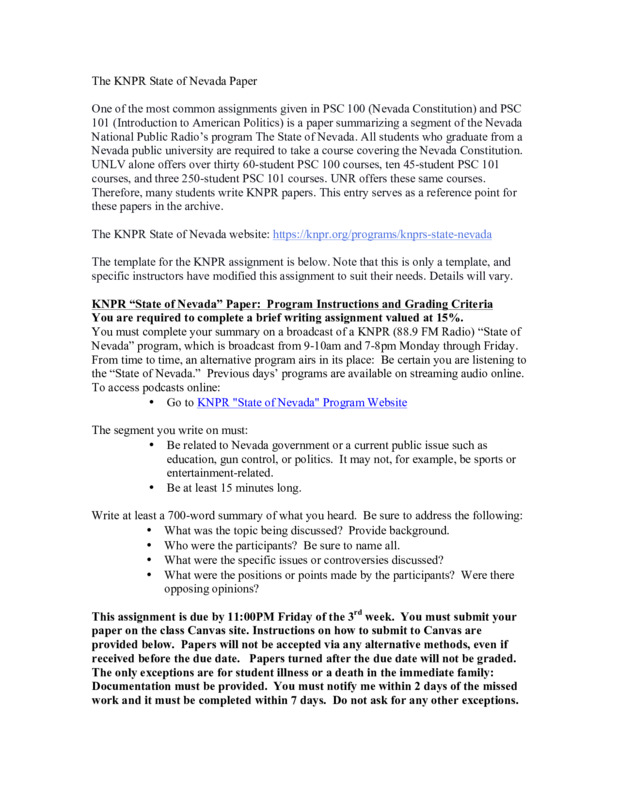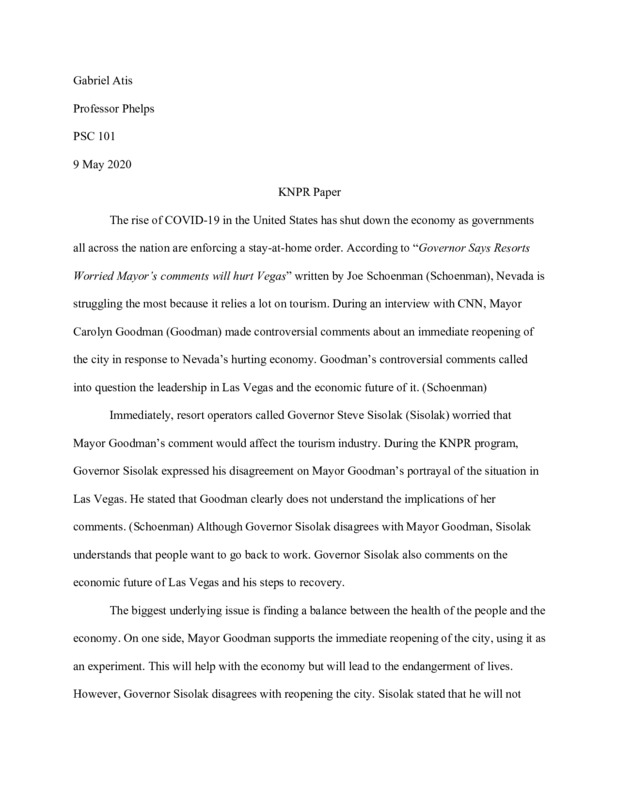Items
topic_interest is exactly
UNLV
-
2020-10-20
Sunshine [DUPLICATE]
These lyrics are from the song “Sunshine” by rapper Young Dolph. This song was released near the beginning of the coronavirus era in April. During this time, I was longing for these difficult times to come to an end, despite them just beginning. I wondered when the sunshine would come back, when all the anxiety and grief would be replaced with relief and glee. The sunshine I had been longing for didn’t come as soon as I expected, but that doesn’t mean I’m giving up hope just yet. -
 2020-05-01
2020-05-01The KNPR State of Nevada Paper
The KNPR State of Nevada Paper One of the most common assignments given in PSC 100 (Nevada Constitution) and PSC 101 (Introduction to American Politics) is a paper summarizing a segment of the Nevada National Public Radio’s program The State of Nevada. All students who graduate from a Nevada public university are required to take a course covering the Nevada Constitution. UNLV alone offers over thirty 60-student PSC 100 courses, ten 45-student PSC 101 courses, and three 250-student PSC 101 courses. UNR offers these same courses. Therefore, many students write KNPR papers. This entry serves as a reference point for these papers in the archive. The KNPR State of Nevada website: https://knpr.org/programs/knprs-state-nevada The template for the KNPR assignment is below. Note that this is only a template, and specific instructors have modified this assignment to suit their needs. Details will vary. KNPR “State of Nevada” Paper: Program Instructions and Grading Criteria You are required to complete a brief writing assignment valued at 15%. You must complete your summary on a broadcast of a KNPR (88.9 FM Radio) “State of Nevada” program, which is broadcast from 9-10am and 7-8pm Monday through Friday. From time to time, an alternative program airs in its place: Be certain you are listening to the “State of Nevada.” Previous days’ programs are available on streaming audio online. To access podcasts online: • Go to KNPR "State of Nevada" Program Website The segment you write on must: • Be related to Nevada government or a current public issue such as education, gun control, or politics. It may not, for example, be sports or entertainment-related. • Be at least 15 minutes long. Write at least a 700-word summary of what you heard. Be sure to address the following: • What was the topic being discussed? Provide background. • Who were the participants? Be sure to name all. • What were the specific issues or controversies discussed? • What were the positions or points made by the participants? Were there opposing opinions? This assignment is due by 11:00PM Friday of the 3rd week. You must submit your paper on the class Canvas site. Instructions on how to submit to Canvas are provided below. Papers will not be accepted via any alternative methods, even if received before the due date. Papers turned after the due date will not be graded. The only exceptions are for student illness or a death in the immediate family: Documentation must be provided. You must notify me within 2 days of the missed work and it must be completed within 7 days. Do not ask for any other exceptions. Grading of the writing assignment will be based on the following: • Your paper must be a minimum of 700 words (excluding your name, date, course, and the title). Shorter papers will have points deducted. • Your assignments will be graded on content as well as style. You should answer the questions thoroughly and thoughtfully and your assignment should be grammatically correct with no misspelled words. The MLA formatting guidelines should be followed and a Works Cited page included. • Points will be deducted from your paper as follows: 1) Discussion of topic: Content & style: 0-50 points off 2) Wrong topic: 100 points off 3) Program other than KNPR’s “State of Nevada:” 100 points off 4) Plagiarized: 100 points off and additional administrative penalties 5) Poor grammar, spelling: Between 5 and 50 points off 6) Failure to comply with MLA guidelines: 5-10 points off 7) Less than 700 words: a. 650-699 words: 10 points off b. 600-649 words: 20 points off c. 550-599 words: 30 points off d. 450-549 words: 40 points off e. 350-450 words: 60 points off f. 250-349 words: 70 points off g. 150-249 words: 80 points off h. <150 words: 100 points off -
 2020-05-17
2020-05-17Student paper on federalism and coronavirus
Maya Martinez Dr. Phelps PSC 401D-1001 State Politics May 14, 2020 Federalism in the Wake of the Coronavirus The United States’ founders initially established a system that granted all authority to the states and none to the federal government, in an attempt to protect against tyrannical executives; when this system of government failed, more authority was granted to the federal level of government, with the caveat of the 10th amendment, which is commonly known as the “states’ rights” amendment. It must have been inconceivable at the time to imagine five different types of federalism would emerge from the founders’ decision to divide power in the United States the way they did. The five types of federalism are dual federalism, cooperative federalism, centralized federalism, new federalism, and ad hoc federalism (Greenblatt and Smith). Dual federalism lasted from 1789 to 1933. It was the variety of federalism that distinctly separated responsibilities and jurisdictions, with federal and state authority in clear layers, like chocoflan. Cooperative federalism was the backlash against dual federalism, occurring once it became clear the federal and state levels of government would always end up overlapping and muddled, never following the clear layers dual federalists advocated for. It lasted from 1933 to 1964. The Great Depression was one of cooperative federalism’s biggest developers as well, as local and state governments relied heavily on the federal government’s money and programs to support their people, granting more authority to the federal government in exchange. Centralized federalism was the next version of federal to take place, occurring from 1964 to 1980; this was a shift of power to the federal government, where grants limited the restrictions placed on states, but the amount of money the federal government gave states as well. New federalism occurred as republicans attempted to limit federal authority and return power to the states, from 1980 to 2002. The last and most recent phase of federalism began after in 2002 and is ongoing at the moment; this is ad hoc federalism. Ad hoc federalism is when the federal government either supports federal authority or states’ rights theory depending on which party is involved. The United States under Covid-19 is still in ad hoc federalism. The governor of Nevada instituted a mandatory stay at home order at the end of March, and like other governors, did not sway at the prodding of a president who only desired for the economy to open up without any concern about citizens’ lives. Economic growth is typically touted by both parties, but when it’s combined with a lack of concern over others’ well-being, it is a desire of the Republican Party. An obvious example of the U.S. still being in ad hoc federalism has been the president at first claiming that governors should be the ones in charge of the pandemic response, until he wanted to open the economy, then started talking about how the president was the most significant person in the country (Borger). Trump was obviously bouncing between federal and state responsibilities based off of what policy suited him and his party, which can also be seen in his preferential treatment of Republican states asking for supplies and resisting assisting blue states (Geltzer). Responses from the federal government, like the $1200 stimulus checks, were largely passed through bi-partisan efforts in Congress and had very little to do with Trump. Clearly, this is one executive who doesn’t know how to handle a pandemic, not that anyone should be surprised. States are lucky enough to have governors smart enough to collaborate to purchase supplies together and not let the president divide them, however, states having to take most of the action has led to a highly uneven response to the pandemic that could only occur under federalism. While it is good to imitate states that have flattened the curve early on like Washington, more unitary governments like South Korea have handled the crisis so quickly, it’s become clear there are advantages to centralized power during times of emergency. Work Cited Borger, Gloria. “Trump Wanted States to Take the Lead on Coronavirus. Until He Didn't.” CNN, Cable News Network, 13 Apr. 2020, www.cnn.com/2020/04/13/politics/borger-analysis-federalism-trump/index.html. Cook, Nancy, and Dan Diamond. “'A Darwinian Approach to Federalism': States Confront New Reality under Trump.” POLITICO, www.politico.com/news/2020/03/31/governors-trump-coronavirus-156875. Diamond, Martin. “The Federalist on Federalism: ‘Neither a National Nor a Federal Constitution, But a Composition of Both.’” The Yale Law Journal , vol. 86, no. 1273, 1977. Geltzer, Joshua A. “Perspective | Trump's 'Corona-Federalism' Pits States against Each Other. It's a Disaster.” The Washington Post, WP Company, 8 Apr. 2020, www.washingtonpost.com/outlook/2020/04/08/trump-corona-federalism/. Glick, Noah, et al. “Novel Coronavirus In Nevada: April 8-14.” KUNR, www.kunr.org/post/novel-coronavirus-nevada-april-8-14#stream/0. Greenblatt, Alan. “Federal-State Relations.” CQ Researcher, vol. 28, no. 16, 27 Apr. 2018. Haffajee, Rebecca L., et al. “Thinking Globally, Acting Locally - The U.S. Response to Covid-19: NEJM.” New England Journal of Medicine, 7 May 2020, www.nejm.org/doi/full/10.1056/NEJMp2006740. Law, John. “How Can We Define Federalism.” Perspectives on Federalism, vol. 5, no. 3, 2013. Smith, Kevin B., and Alan Greenblatt. “Chapter 2 Federalism.” Governing States and Localities, 7th ed., CQ Press, 2020, pp. 23–47. Wilson, Chris. “Here's How Quickly Coronavirus Is Spreading in Your State.” Time, Time, 13 May 2020, time.com/5814139/coronavirus-state-data-tracker/. -
 2020-05-11
2020-05-11Questioning the leadership in Las Vegas and the economic future of it.
Governer Sisolak response to Mayor Goodman's statement about reopening the city of Las Vegas.
